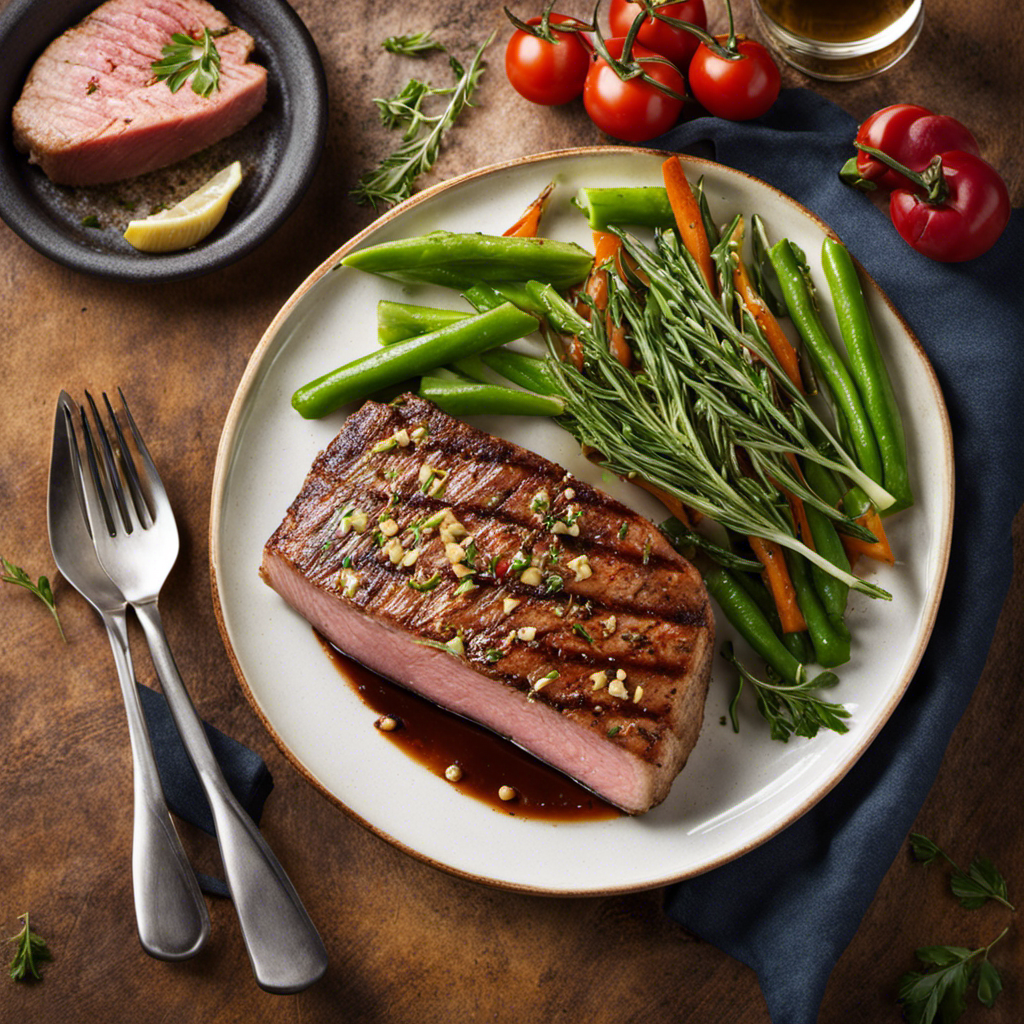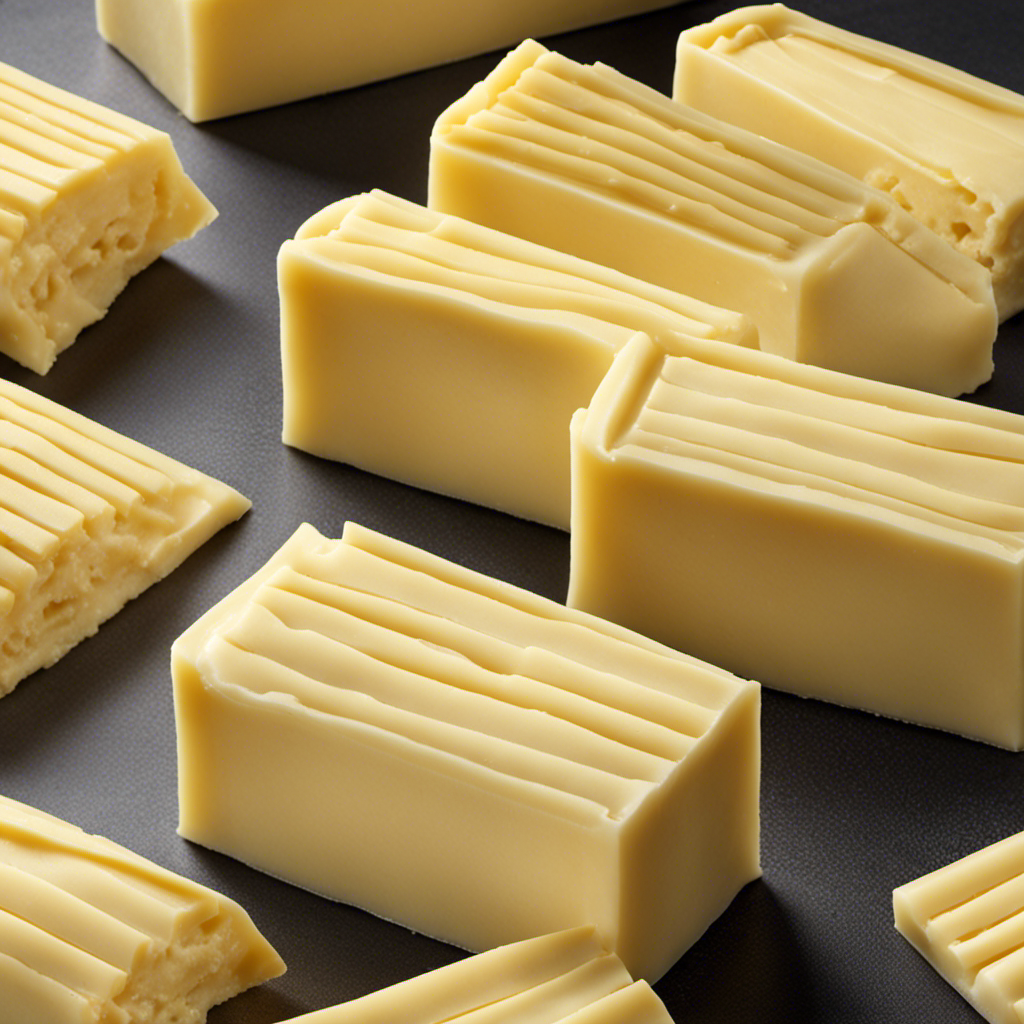I have found an infallible method for preparing a tasty tuna steak in a pan using butter. The key is in the ideal mix of temperature, spices, and duration.
In this article, I’ll guide you through the steps to achieve a mouthwatering tuna steak that is tender, flavorful, and cooked to perfection.
So, let’s dive in and learn the art of cooking a tuna steak that will impress even the most discerning palates.
Key Takeaways
- Choosing a fresh and vibrant-colored tuna steak is important for a delicious dish.
- Preheating the pan and searing the tuna steak for 1-2 minutes per side on medium-high heat creates a crispy crust and juicy center.
- Butter basting techniques, such as continuously basting the steak with melted butter, enhance flavor and juiciness.
- Resting the tuna steak before serving allows the juices to redistribute, resulting in a more flavorful and tender steak.
Choosing the Right Tuna Steak
When choosing the right tuna steak, it’s important to look for a piece that is fresh and has a vibrant color. Freshness is key to ensuring the best flavor and texture in your tuna steak. Look for a steak that is firm and has a bright, shiny appearance. Avoid any signs of discoloration or a strong fishy smell.
Once you have chosen your fresh tuna steak, consider marinating it to enhance its flavor. A simple marinade of olive oil, lemon juice, garlic, and herbs can add a delicious taste to your tuna. Marinating the tuna steak for at least 30 minutes before cooking allows the flavors to penetrate the meat.
Now that you have chosen and marinated your tuna steak, it’s time to move on to preparing it for cooking.
Preparing the Tuna Steak
Before starting, make sure you have all the necessary ingredients and utensils ready.
To prepare the tuna steak, begin by patting it dry with paper towels to remove any excess moisture. This will help the butter to adhere better to the surface of the steak.
Next, season both sides of the steak with salt and pepper to enhance the flavor.
Heat a pan over medium-high heat and add a generous amount of butter. Once the butter is melted and sizzling, carefully place the tuna steak in the pan.
Cook for about 2-3 minutes on each side, or until the desired level of doneness is reached. Remember to not overcook the steak, as it can become dry and tough.
Alternatively, you can also grill or broil the tuna steak for a different cooking method.
Once cooked, let the steak rest for a few minutes before slicing it against the grain.
Serve the tuna steak with a squeeze of lemon, a side of mixed greens, and some roasted potatoes for a delicious and satisfying meal.
Seasoning the Tuna Steak
To enhance the flavor of your tuna steak, you’ll want to generously season both sides with salt and pepper. This is an important step in bringing out the natural taste of the fish.
However, if you want to take your seasoning to the next level, you can try a marinating technique using herbs. Herbs like rosemary, thyme, and dill can add a delightful aroma and depth of flavor to your tuna steak. Simply mix together your preferred herbs with some olive oil and let the steak marinate for about 30 minutes before cooking. This will infuse the flavors into the meat and create a more flavorful experience.
Now that your tuna steak is seasoned to perfection, it’s time to move on to preheating the pan.
Preheating the Pan
When it comes to cooking, two key factors to consider are the optimal pan temperature and the choice between using butter or oil.
In my experience, achieving the right pan temperature is crucial for ensuring even cooking and preventing sticking.
I have found that using butter adds a rich flavor to dishes, while oil provides a neutral base that allows the flavors of the ingredients to shine through.
Optimal Pan Temperature
The optimal pan temperature for cooking tuna steak is around medium-high heat. This temperature allows for the optimal sear, ensuring a crispy crust on the outside while keeping the inside tender and juicy.
Achieving the perfect sear on a tuna steak is crucial to enhance its flavors and texture. To achieve this, preheat your pan over medium-high heat and add a small amount of butter. Allow the butter to melt and coat the pan evenly.
Once the pan is hot, carefully place the tuna steak in the pan and cook for about 1-2 minutes per side, depending on the thickness of the steak. This high heat will give the steak a beautiful sear and a deliciously crispy crust.
Butter Vs. Oil
If you want to achieve a crispy crust on your tuna steak, consider using oil instead of butter for cooking. While butter adds a rich and flavorful taste to dishes, it may not be the best choice when it comes to cooking tuna steak.
Here are a few reasons why oil may be a better option:
-
Higher smoke point: Oil has a higher smoke point compared to butter, which means it can withstand higher cooking temperatures without burning. This is important when searing tuna steak to perfection.
-
Health benefits: While butter contains saturated fats, which can raise cholesterol levels, certain oils like olive oil and avocado oil are high in monounsaturated fats, which can have heart-healthy benefits.
Adding Butter to the Pan
To get started, you’ll wanna melt some butter in the pan. The butter melting process is essential as it adds richness and flavor to the tuna steak. Butter has a lower smoke point compared to alternative cooking fats like oil, but its distinct taste makes it a popular choice for cooking fish. Here is a helpful table showcasing the smoke points of different cooking fats:
| Cooking Fat | Smoke Point (°F) |
|---|---|
| Butter | 350°F |
| Olive Oil | 375°F |
| Canola Oil | 400°F |
| Avocado Oil | 520°F |
| Peanut Oil | 450°F |
Now that we have melted the butter, we can move on to searing the tuna steak, which will lock in the juices and create a delicious crust on the outside.
Searing the Tuna Steak
When it comes to searing a tuna steak, two key factors that need to be considered are the temperature and the cooking time.
The temperature for searing should be high, around 400-450°F, to achieve that desirable crust on the outside while keeping the inside rare or medium-rare.
Cooking time for searing depends on the thickness of the tuna steak, typically ranging from 1-2 minutes per side for a 1-inch thick steak.
Temperature for Searing
The ideal temperature for searing a tuna steak in a pan with butter is around 400 degrees Fahrenheit. This temperature allows for the perfect balance between achieving a crispy crust on the outside while maintaining a tender and juicy center. Searing the tuna steak at this temperature ensures that it cooks quickly and evenly, sealing in the flavors and juices.
To grab your attention, here are two important points to consider when searing tuna steak at the optimal temperature:
-
Optimal Searing Time
-
Searing a tuna steak for about 1-2 minutes on each side will give it a beautiful golden brown crust while keeping the inside rare to medium-rare, which is the preferred doneness for tuna.
-
Overcooking the tuna steak can result in a dry and tough texture, so it’s important to keep a close eye on the searing time.
-
Achieving a Crispy Crust
-
Preheating the pan before adding the butter and tuna steak helps to create a sizzling hot surface, allowing the butter to melt quickly and evenly, and ensuring a crispy crust.
-
Using butter instead of oil adds a rich flavor to the tuna steak and enhances its overall taste.
Cooking Time for Searing?
For perfectly seared tuna steaks, you’ll want to keep a close eye on the searing time to avoid overcooking and maintain a tender texture.
The cooking time for grilling tuna steaks can vary depending on the thickness of the steak and the desired level of doneness. As a general guideline, it is recommended to cook a one-inch thick tuna steak for about 1-2 minutes per side over high heat. This will result in a rare to medium-rare steak, which is the ideal doneness for tuna.
However, if you prefer a more well-done steak, you can increase the cooking time accordingly.
It’s important to note that searing is not the only cooking method for tuna steaks. Alternative methods such as broiling, baking, or even sous vide can also be used to cook tuna to perfection. Each method will require a different cooking time, so it’s essential to adjust accordingly.
Flipping the Tuna Steak
To flip the tuna steak in the pan, you’ll want to gently slide a spatula under the steak and quickly turn it over. This flipping technique is crucial to ensure even cooking and prevent overcooking.
Here are some key points to keep in mind when flipping your tuna steak:
- Use a sturdy spatula: Choose a spatula that is wide enough to support the entire steak without breaking it apart.
- Be gentle: Avoid applying too much pressure when sliding the spatula under the steak to prevent it from falling apart.
- Flip quickly: Once the spatula is underneath the tuna steak, swiftly flip it over to the other side.
- Maintain heat: Ensure that the pan remains hot throughout the flipping process to maintain the desired level of sear.
Basting the Tuna Steak With Butter
When it comes to cooking a tuna steak, one of the techniques I highly recommend is butter basting. This simple yet effective method involves continuously spooning melted butter over the steak during the cooking process.
Not only does this enhance the flavor of the tuna, but it also helps to keep it juicy and moist.
Butter Basting Techniques
Butter basting is a popular technique for cooking tuna steak in a pan with a rich and flavorful taste. When it comes to butter basting techniques, there are a few alternative cooking methods that you can consider. Here are two sub-lists to grab your attention:
-
Butter Basting Techniques:
- Traditional Method: Heat a pan over medium-high heat and add butter. Once the butter has melted, place the tuna steak in the pan and cook for a few minutes on each side, continuously basting the steak with the melted butter.
- Sous Vide Method: Vacuum seal the tuna steak with butter and cook it in a water bath at a precise temperature for a specific amount of time. Afterward, sear the steak in a hot pan with additional butter for extra flavor.
-
Alternative Cooking Methods:
- Grilling: Instead of cooking the tuna steak in a pan, you can grill it over high heat. Baste the steak with melted butter while it’s on the grill to enhance the flavor.
- Oven Roasting: Preheat your oven and roast the tuna steak with butter in a baking dish until it reaches your desired doneness. Baste the steak occasionally during the cooking process for a juicy result.
Incorporating these butter basting techniques and alternative cooking methods will elevate your tuna steak to a whole new level of deliciousness.
Enhancing Flavor and Juiciness
Now that we’ve covered the butter basting techniques for cooking tuna steak, let’s move on to enhancing its flavor and juiciness.
One way to elevate the presentation of your tuna steak is by adding a sprinkle of freshly chopped herbs, such as parsley or cilantro, right before serving. This not only adds a pop of color but also enhances the overall taste.
Additionally, consider pairing your tuna steak with complementary side dishes. For example, a refreshing citrus salad or a bed of sautéed vegetables can provide a delightful contrast to the richness of the tuna. These side dishes not only add variety to your meal but also help balance the flavors.
Now that we have discussed enhancing the flavor and presentation, let’s move on to the next step: checking the doneness of the tuna steak.
Checking the Doneness of the Tuna Steak
To check if your tuna steak is cooked to your liking, gently press the center with your finger. This will help you gauge the doneness of the steak.
Here are some tips to ensure you achieve the perfect sear and test for doneness:
-
Look for a firm texture: A properly cooked tuna steak should be firm but still tender. Gently press the center of the steak with your finger and feel for a slight resistance.
-
Check the color: Tuna steaks are best enjoyed when cooked medium-rare to medium. The center should be pink or reddish, indicating a perfectly cooked steak.
Once you have tested for doneness and achieved that beautiful sear, it is important to let the tuna steak rest before serving. This allows the juices to redistribute, resulting in a more flavorful and juicy steak.
Now, let’s move on to the next step: resting the tuna steak.
Resting the Tuna Steak
Make sure you set the tuna steak aside and allow it to rest for a few minutes before serving. Resting the tuna steak is an important step in the cooking process as it allows the juices to redistribute throughout the meat, resulting in a more flavorful and tender steak.
When the tuna steak is cooked, the heat causes the juices to move towards the center of the meat. By letting it rest, these juices have time to evenly distribute, ensuring that each bite is moist and delicious. Resting also helps to retain the natural flavors of the tuna, making for a more enjoyable dining experience.
Once the tuna steak has rested, it is ready to be served and enjoyed.
Serving and Enjoying the Tuna Steak
After resting, the tuna steak is ready to be savored and enjoyed. Here are some serving suggestions and wine pairings to enhance your dining experience:
-
Serving Suggestions:
-
Slice the tuna steak and arrange it on a bed of mixed greens for a refreshing salad.
-
Serve the tuna steak on a warm bed of quinoa or couscous, accompanied by sautéed vegetables.
-
Wine Pairings:
-
For a light and crisp option, try a Sauvignon Blanc or a Pinot Grigio. These wines complement the delicate flavors of the tuna.
-
If you prefer a fuller-bodied wine, opt for a Chardonnay or a Pinot Noir. These wines will bring out the richness of the tuna steak.
Remember to serve the tuna steak immediately after cooking to preserve its tenderness and flavor. Enjoy your meal!
Frequently Asked Questions
How Long Should I Preheat the Pan Before Adding the Butter?
I usually preheat the pan for about 2-3 minutes before adding the butter. It allows the butter to melt evenly and creates a nice sear on the tuna steak. Alternatively, you can use other oils like olive oil or avocado oil for a different flavor.
Can I Use a Different Type of Oil Instead of Butter?
Using oil instead of butter for cooking tuna steak can significantly alter its flavor profile. Different types of oil, such as olive oil or sesame oil, can impart unique tastes that enhance or complement the natural flavors of the fish.
What Is the Recommended Cooking Time for a Medium-Rare Tuna Steak?
For a perfectly medium-rare tuna steak, the recommended cooking time depends on the thickness of the steak. A general guideline is to cook it on high heat for 1-2 minutes per side.
What Other Seasonings Can I Use to Enhance the Flavor of the Tuna Steak?
To enhance the flavor of a tuna steak, I recommend using a variety of seasonings such as garlic, lemon zest, or a sprinkle of freshly ground black pepper. Experimenting with different cooking methods can also bring out the best in the tuna.
Can I Use Frozen Tuna Steaks for This Recipe?
Using frozen tuna steaks is possible for this recipe, but fresh tuna steaks are recommended for best results. To defrost frozen tuna steaks, place them in the refrigerator overnight or use the defrost setting on your microwave.
Conclusion
In conclusion, cooking a tuna steak in a pan with butter is a delectable experience that will leave your taste buds sizzling with delight.
By carefully selecting the right tuna steak, preparing it with precision, and adding a touch of buttery goodness, you can create a dish that is both succulent and flavorful.
Remember to baste the steak with butter, allowing it to soak up the rich flavors, and check for doneness to ensure a perfectly cooked piece of fish.
So go ahead, indulge in this culinary adventure and savor every mouthwatering bite.










